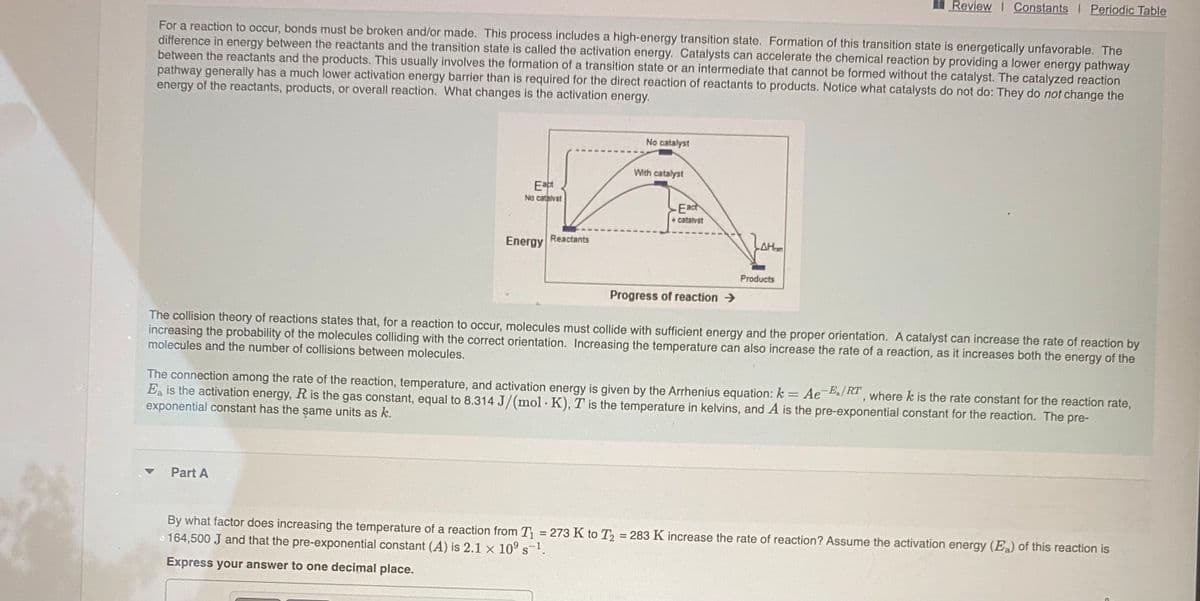By what factor does increasing the temperature of a reaction from T = 273 K to T = 283 K increase the rate of reaction? Assume the activation energy (E) of this reaction is 164,500 J and that the pre-exponential constant (A) is 2.1 x 10° s-1. Express your answer to one decimal place.
By what factor does increasing the temperature of a reaction from T = 273 K to T = 283 K increase the rate of reaction? Assume the activation energy (E) of this reaction is 164,500 J and that the pre-exponential constant (A) is 2.1 x 10° s-1. Express your answer to one decimal place.
Chemistry
10th Edition
ISBN:9781305957404
Author:Steven S. Zumdahl, Susan A. Zumdahl, Donald J. DeCoste
Publisher:Steven S. Zumdahl, Susan A. Zumdahl, Donald J. DeCoste
Chapter1: Chemical Foundations
Section: Chapter Questions
Problem 1RQ: Define and explain the differences between the following terms. a. law and theory b. theory and...
Related questions
Question

Transcribed Image Text:Review I Constants Periodic Table
For a reaction to occur, bonds must be broken and/or made. This process includes a high-energy transition state. Formation of this transition state is energetically unfavorable. The
difference in energy between the reactants and the transition state is called the activation energy. Catalysts can accelerate the chemical reaction by providing a lower energy pathway
between the reactants and the products. This usually involves the formation of a transition state or an intermediate that cannot be formed without the catalyst. The catalyzed reaction
pathway generally has a much lower activation energy barrier than is required for the direct reaction of reactants to products. Notice what catalysts do not do: They do not change the
energy of the reactants, products, or overall reaction. What changes is the activation energy.
No catalyst
With catalyst
Ead
Na cataivst
Eac
+ catalvst
Reactants
Energy
Products
Progress of reaction >
The collision theory of reactions states that, for a reaction to occur, molecules must collide with sufficient energy and the proper orientation. A catalyst can increase the rate of reaction by
increasing the probability of the molecules colliding with the correct orientation. Increasing the temperature can also increase the rate of a reaction, as it increases both the energy of the
molecules and the number of collisions between molecules.
The connection among the rate of the reaction, temperature, and activation energy is given by the Arrhenius equation: k = Ae Ba/RI where k is the rate constant for the reaction rate,
Ea is the activation energy, R is the gas constant, equal to 8.314 J/(mol K), T is the temperature in kelvins, and A is the pre-exponential constant for the reaction. The pre-
exponential constant has the same units as k.
Part A
By what factor does increasing the temperature of a reaction from T = 273 K to T, = 283 K increase the rate of reaction? Assume the activation energy (E) of this reaction is
164,500 J and that the pre-exponential constant (A) is 2.1 x 10° s-1.
Express your answer to one decimal place.
Expert Solution
This question has been solved!
Explore an expertly crafted, step-by-step solution for a thorough understanding of key concepts.
This is a popular solution!
Trending now
This is a popular solution!
Step by step
Solved in 2 steps

Recommended textbooks for you

Chemistry
Chemistry
ISBN:
9781305957404
Author:
Steven S. Zumdahl, Susan A. Zumdahl, Donald J. DeCoste
Publisher:
Cengage Learning

Chemistry
Chemistry
ISBN:
9781259911156
Author:
Raymond Chang Dr., Jason Overby Professor
Publisher:
McGraw-Hill Education

Principles of Instrumental Analysis
Chemistry
ISBN:
9781305577213
Author:
Douglas A. Skoog, F. James Holler, Stanley R. Crouch
Publisher:
Cengage Learning

Chemistry
Chemistry
ISBN:
9781305957404
Author:
Steven S. Zumdahl, Susan A. Zumdahl, Donald J. DeCoste
Publisher:
Cengage Learning

Chemistry
Chemistry
ISBN:
9781259911156
Author:
Raymond Chang Dr., Jason Overby Professor
Publisher:
McGraw-Hill Education

Principles of Instrumental Analysis
Chemistry
ISBN:
9781305577213
Author:
Douglas A. Skoog, F. James Holler, Stanley R. Crouch
Publisher:
Cengage Learning

Organic Chemistry
Chemistry
ISBN:
9780078021558
Author:
Janice Gorzynski Smith Dr.
Publisher:
McGraw-Hill Education

Chemistry: Principles and Reactions
Chemistry
ISBN:
9781305079373
Author:
William L. Masterton, Cecile N. Hurley
Publisher:
Cengage Learning

Elementary Principles of Chemical Processes, Bind…
Chemistry
ISBN:
9781118431221
Author:
Richard M. Felder, Ronald W. Rousseau, Lisa G. Bullard
Publisher:
WILEY